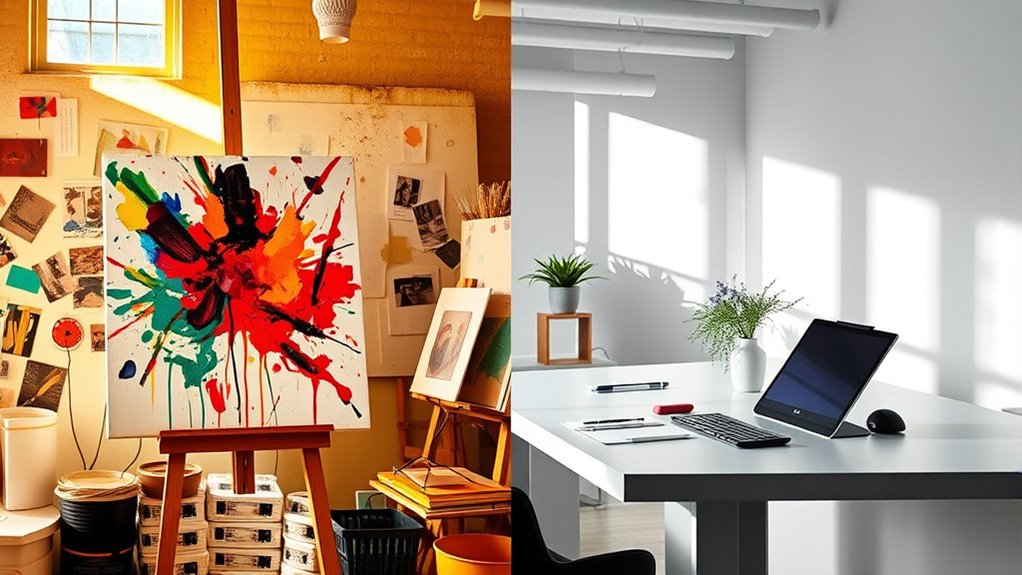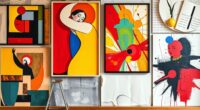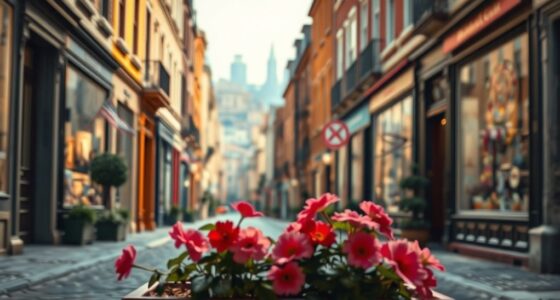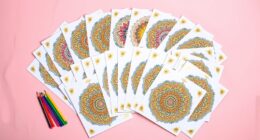Understanding the difference between art and design helps you see how each uses creativity for different goals. Art is driven by personal expression, emotion, and exploring ideas without concern for utility, often encouraging individual interpretation. Design, on the other hand, focuses on solving specific problems by communicating clear messages efficiently through visuals. If you want to explore how these approaches influence their use of creativity, just keep exploring this fascinating distinction.
Key Takeaways
- Art emphasizes personal expression and emotional impact, while design focuses on solving specific problems through strategic communication.
- Art allows for spontaneity and exploration, whereas design follows a structured, goal-oriented process.
- Art aims to evoke individual interpretation and reflection, whereas design seeks clarity and effective message delivery.
- Artistic thinking values originality and experimentation; design prioritizes practicality and functionality.
- Art often produces non-utilitarian, provocative works; design produces solutions that are functional and user-centered.
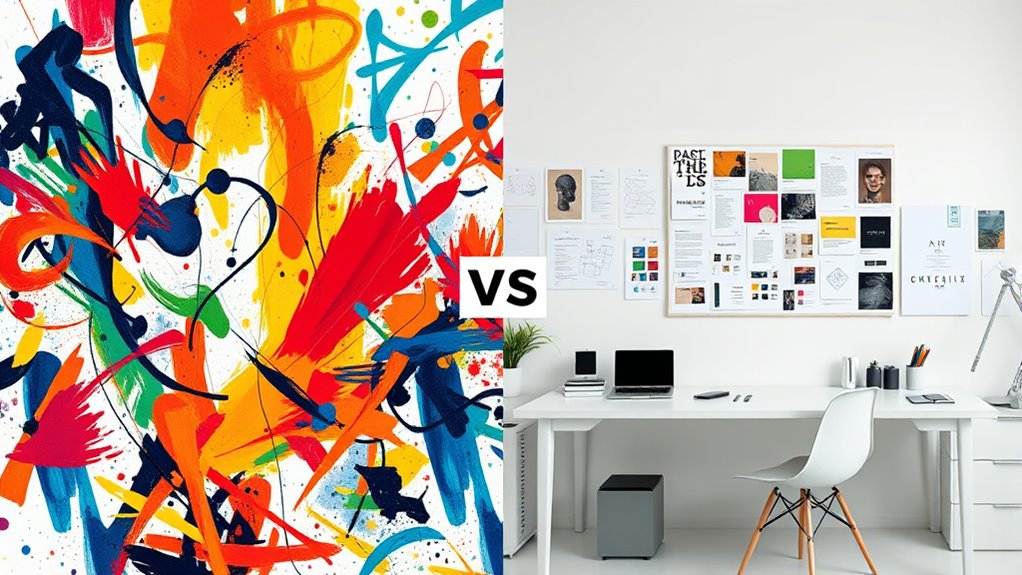
Have you ever wondered what truly distinguishes art from design? At their core, these fields often overlap, but they serve different purposes and follow distinct approaches. When you explore the creative process behind each, you’ll notice that art is driven by personal expression, emotion, and the desire to evoke a response. It’s an open-ended journey where the artist explores ideas, feelings, or concepts without necessarily considering how others will interpret or use the work. In contrast, design revolves around solving specific problems through a strategic creative process. It’s about producing solutions that communicate ideas clearly and effectively, often with a particular audience or goal in mind.
Visual communication is fundamental in both art and design, but the way it’s used highlights their differences. In art, visual communication is often about conveying complex emotions, abstract ideas, or personal viewpoints. The artist might experiment with colors, forms, and techniques to express a feeling or challenge perceptions, leaving interpretation open to viewers. Art’s visual language invites individual reflection, making it more subjective. Design, however, employs visual communication as a tool to deliver a message quickly and efficiently. Every element—typography, layout, imagery—is chosen deliberately to guide viewers toward understanding a specific idea or call to action. The purpose is to create clarity, not ambiguity.
Visual communication in art fosters personal reflection, while in design, it ensures clarity and immediate understanding.
The creative process in art is more fluid and exploratory. You might start with a spontaneous idea or emotion and let it evolve naturally, often without a predetermined outcome. It’s a process rooted in intuition, where mistakes or surprises become part of the final piece. Design’s creative process is more structured and goal-oriented. You typically begin with research and understanding of the problem, then develop concepts, test ideas, and refine them based on feedback. The emphasis is on usability, functionality, and meeting client or user needs. Additionally, understanding different brewing techniques can enhance the appreciation of how a well-crafted solution, whether in art or design, requires precision and skill. Recognizing the importance of cost factors can also influence how a project develops from concept to completion. Moreover, the creative process in design often involves multiple iterations to optimize effectiveness and ensure alignment with objectives. Interestingly, learning about art history can deepen your understanding of how visual styles evolve and influence contemporary design practices.
While art values originality and personal voice, design prioritizes efficiency and practicality. Art can challenge norms and provoke thought without regard for immediate utility, whereas design aims to communicate clearly and solve specific problems. Both fields require creativity, but their applications reflect different philosophies: art seeks to inspire and provoke, while design seeks to inform and facilitate understanding. Recognizing these distinctions helps you appreciate the unique contributions of each discipline and how they shape our visual world in diverse ways.
Frequently Asked Questions
Can Art and Design Overlap in Professional Projects?
In professional projects, art and design definitely overlap, especially through creative collaboration. You can blend aesthetic integration with functional goals, allowing artistic expression to enhance design solutions. When you combine these elements, you create innovative work that’s both visually appealing and purposeful. This synergy fosters unique perspectives and richer outcomes, proving that art and design can work together seamlessly, enriching your projects and pushing creative boundaries.
How Do Personal Biases Influence Artistic Versus Design Decisions?
Like a painter with a brush, your personal biases shape your decisions. In art, subjectivity bias allows you to express your unique perspective, influenced by cultural factors. In design, however, you’re more focused on user needs, so biases must be managed to prioritize functionality. Recognizing how cultural influences sway your choices helps you create more authentic art and effective designs, balancing personal expression with audience needs.
Which Approach Offers More Flexibility: Art or Design?
You might find that art offers more flexibility because it prioritizes creative freedom and personal expression without strict structural constraints. In contrast, design often involves working within specific parameters to meet functional goals, which can limit flexibility. If you seek open-ended exploration and spontaneous ideas, art provides greater freedom. However, if you prefer structured problem-solving, design balances creativity with necessary constraints.
How Do Audience Perceptions Differ Between Art and Design?
Imagine stepping into a gallery or a showroom—your perception shifts like a kaleidoscope. With art, you feel an emotional response, like a whisper to your soul, shaped by cultural interpretations that paint personal meaning. In design, your perception is more functional, like reading a map—focused on clarity and purpose. Audience perceptions differ because art invites deep emotional engagement, while design emphasizes understanding and usability.
Are There Specific Industries Where One Clearly Dominates?
You’ll notice that in industries like advertising, branding, and fashion, design clearly dominates because of industry trends emphasizing visual communication and user experience. Conversely, in fine arts and entertainment, artistic thinking takes the lead, focusing on personal expression and emotional impact. Your understanding of these creative processes helps you adapt strategies to industry demands, ensuring your work aligns with trends and audience expectations across different sectors.
Conclusion
Ultimately, art and design serve different purposes—one sparks emotion, the other solves problems. While art invites you to explore and feel freely, design guides you with intent and function. Both require creativity, but their focus diverges. Recognize that embracing both allows you to balance raw expression with purposeful innovation. In this dance between art and design, you discover that true creativity thrives when emotion meets purpose, transforming ideas into meaningful experiences.
